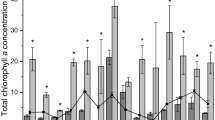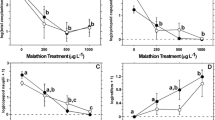Abstract
Seasonal variations in plankton community response to pentachlorophenol (PCP) were studied in four mesocosm experiments using enclosures in a small lake. The mesocosms (860 l) were dosed with single applications of technical grade PCP (0, 4, 10, 24, 36, 54, 81 and 121 μg/l PCP) and monitored for 20 days. Multivariate statistical analyses showed that plankton community taxonomic composition varied with season. In winter and spring, communities were most stable in time; species diversity and abundance were lowest in winter. Seasonally, the communities varied little with respect to the dominant species, which were the copepod Calamoecia lucasi, the alga Peridinium sp. and the rotifer Ascomorpha ovalis. The direct effects of the PCP additions varied little between seasons, but indirect effects were evident at lower treatment levels in autumn. Indirect effects were not evident in winter. Minor variations in plankton community responses to PCP with season were apparent in the following order of decreasing sensitivity; autumn ≥ winter/spring ≥ summer. At the species level, C. lucasi showed the largest response. The responses observed were greatest in autumn, with decreased abundance at PCP concentrations ≥ 24 μg/l. In the other seasons, effects were observed at levels of 54 or 81μg/l and higher. Ascomorpha ovalis was the most responding rotifer in winter and spring, whereas Anuraeopsis fissa responded more strongly in autumn and summer. The dinoflagellate alga Peridinium sp. had the largest negative response in all but winter, when Dinobryon cylindricum did. Cryptomonas sp. responded positively to PCP in all seasons, increasing in abundance in the highest treatments, possibly due to reduced grazing pressure, reduced competition, or increased decomposition. The plankton community no-observed effect-concentration (NOEC) was 24–36 μg/l PCP. Results reported here suggest that the Australian and New Zealand water quality guideline values for PCP are sufficient to protect plankton communities against adverse effects.
Similar content being viewed by others
References
T. Aldenberg W. Slob (1993) ArticleTitleConfidence limits for hazardous concentrations based on logistically distributed NOEC toxicity data Ecotoxicol. Environ. Saf. 25 48–63
ANZECC water quality guidelines (2000). Australia and New Zealand Environment and Conservation Council and Agricultural and Resource Management Council of Australia and New Zealand, 2000. Australian and New Zealand Guidelines for Fresh and Marine Water Quality. ANZECC and ARMCANZ. (www.deh.gov.au/water/quality/nwqms/introduction)
Blinn, D.W. and Stewart, A.J. (1973). Responses of natural phytoplankton populations to treatment with simazine. Technical Report to CIBA Geigy Co. 12 pp
C.W. Burns (1991) ArticleTitleNew Zealand lakes research, 1967–91 N.Z. J. Mar.FW. Res. 25 359–79
J.D. Cooney G.M. DeGreave E.L. Moore W.D. Palmer T.L. Pollock (1992) ArticleTitleEffects of food and water quality on culturing of Ceriodaphnia dubia Environ. Toxicol. Chem. 11 823–37
H. Croasdale E.A. Flint (1986) Flora of New Zealand. Freshwater Algae, Chlorophyta, desmids. V.R. Ward, Government Printer Wellington, NZ
N.O. Crossland C.J.M. Wolfe (1985) ArticleTitleFate and biological effects of pentachlorophenol in outdoor ponds Environ. Toxicol. Chem. 4 73–86
Donald, R.C. (1990). The selectivity of lacaustrine smelt (Retropinna retropinna R.) for limnetic Crustacea. Unpublished M.Sc Thesis, University of Waikato, Hamilton, NZ, 107 pp.
Etheredge, M.K. (1983). The seasonal biology of phytoplankton in Lake Maratoto and Lake Rotomanuka. Unpublished M.Sc. Thesis, University of Waikato, Hamilton, NZ, 264 pp.
Etheredge, M.K. (1987). The phytoplankton communities of nine lakes, Waikato, New Zealand. Unpublished Ph.D. Thesis, University of Waikato, Hamilton, NZ, 462 pp.
D. Feind F. Zieris W. Huber (1988) ArticleTitleEffects of sodium pentachlorophenate on the ecology of a freshwater model ecosystem Environ. Pollut. 50 211–23
R.A. Fisher (1948) Statistical Methods for Research Worker EditionNumber10 Oliver and Boyd Edinburgh
T. Hanazoto M. Yasuno (1987) ArticleTitleEffects of a carbamate insecticide, carbaryl, on the summer phyto- and zooplankton communities in ponds Environ. Pollut. 48 145–159
T. Hanazoto M. Yasuno (1990) ArticleTitleInfluence of time of application of an insecticide on recovery patterns of a zooplankton community in experimental ponds Arch. Environ. Contam. Toxicol. 19 77–83
R. Hobro E. Willén (1977) ArticleTitlePhytoplankton countings, intercalibration results and recommendations for routine work Int. Rev. Ges. Hydrobiol. 62 805–11
A. Joern K.D. Hoagland (1996) ArticleTitleIn defense of whole-community bioassays for risk assessment Environ. Toxicol. Chem. 25 407–409
A.C. Kindig L.L. Conquest F.B. Taub (1983) Differential sensitivity of new versus mature synthetic microcosms to streptomycin sulphate treatment. W.E. Bishop R.D. Cardwell B.B. Heidolph (Eds) Aquatic Toxicology and Hazard Assessment. Sixth Symposium, ASTM STP 802 American Society for Testing and Materials Philadelphia, PA 193–203
D.R. Lee (1980) Reference toxicants in quality control of aquatic bioassays. A.L. Buikema J. Cairns SuffixJr. (Eds) Aquatic Invertebrate Bioassays, ASTM STP 715. American Society for Testing and Materials Philadelphia, PA 180–200
K. Liber N.K. Kaushik K.R. Solomon J.H. Carey (1992) ArticleTitleExperimental designs for aquatic mesocosm studies: a comparison of the ANOVA and regression design for assessing the impact of tetrachlorophenol on zooplankton populations in limnocorrals Environ. Toxicol. Chem. 11 61–77
D.J. Lowe J.D. Green (1987) Origins and development of the lakes A.B. Viner (Eds) Inland Waters of New Zealand DSIR Science Information Publishing Centre Wellington 193–203
T.J. Norberg-King S. Schmidt (1993) ArticleTitleComparison of effluent toxicity results using Ceriodaphnia dubia cultured on several diets Environ. Toxicol. Chem. 12 1945–55
A. Peither I. Jüttner A. Kettrup J. Lay (1996) ArticleTitleA pond mesocosm study to determine the direct and indirect effects of lindane on a natural zooplankton community Environ. Pollut. 93 49–56
Prescott, G.W. (1978). How to Know the Freshwater Algae. 3rd edn. 293 pp. The Pictured Key Nature Series. Wm. C. Brown Company Publishers Dubuque, Iowa
Pridmore, R. and Hewitt, J. (1982). A Guide to the Common Freshwater Algae in New Zealand. 46 pp. Water and Soil Miscellaneous Publication No. 39, Wellington
W. Schauerte J.P. Lay W. Klein F. Korte (1982) ArticleTitleInfluence of 2,4,6-trichlorophenol and pentachlorophenol on the biota of aquatic systems Chemosphere 11 71–79
Shiel, R.J. (1995). A Guide to Identification of Rotifers, Cladocerans and Copepods from Australian Inland Waters. 144 pp. Co-operative Research Centre for Freshwater Ecology Identification Guide No. 3.
A.J. Stewart R.G. Wetzel (1986) ArticleTitleCryptophytes and other microflagellates as couplers in planktonic community dynamics Arch. Hydrobiol. 106 1–15
G.L. Swartzman F.B. Taub J. Meador C. Huang A. Kindig (1990) ArticleTitleModelling the effect of algal biomass on multispecies aquatic microcosms response to copper toxicity Aquat. Toxicol. 17 93–118
F.B. Taub (1997) ArticleTitleUnique information contributed by multispecies systems: examples from the standardized aquatic microcosm Ecol. Appl. 7 1103–10
F.B. Taub A.C. Kindig J.P. Meador G.L. Swartzman (1991) ArticleTitleEffects of seasonal succession and grazing on copper toxicity in aquatic microcosms Verh. Int. Verein. Limnol. 24 2205–2214
C.J.F. Ter Braak P. Smilauer (1998) CANOCO reference manual and user’s guide to Canoco for Windows: software for canonical community ordination (version 4). Microcomputer Power Ithaca, New York
H. Utermöhl (1958) ArticleTitleZur vervollkomnung der quantitative phytoplankton-methodik Mitt. Int. Verein. Theoret. Ang. Limnol. 9 81–6
P.J. Brink ParticleVan den J. Hattink F. Bransen E. Donk ParticleVan T.C.M. Brock (2000) ArticleTitleImpact of the fungicide carbendazim in freshwater microcosms. II. Zooplankton primary producers and final conclusions. Aquat. Toxicol. 48 251–64
P.J. Brink ParticleVan den C.J.F. Ter Braak (1998) ArticleTitleMultivariate analysis of stress in experimental ecosystems by Principal Response Curves and similarity analysis Aquat. Ecol. 32 163–78
P.J. Brink ParticleVan den C.J.F. Ter Braak (1999) ArticleTitlePrincipal response curves: analysis of time-dependent multivariate responses to biological community stress Environ. Toxicol. Chem. 18 138–48
P.J. Brink ParticleVan den N.W. Brink ParticleVan den C.J.F. Ter Braak (2003) ArticleTitleMultivariate analysis of ecotoxicological data using ordination: demonstrations of utility on the basis of various examples Australas. J. Ecotoxicol. 9 141–56
P.J. Brink ParticleVan den R.P.A. Wijngaarden ParticleVan W.G.H. Lucassen T.C.M. Brock P. Leeuwangh (1996) ArticleTitleEffects of the insecticide Dursban 4E (active ingredient chlorpyrifos) in outdoor experimental ditches: II. Invertebrate community responses and recovery. Environ. Toxicol. Chem. 15 1143–53
D.A. Williams (1972) ArticleTitleThe comparison of several dose levels with zero dose control Biometrics 28 519–31
Willis, K.J. (1999a). From single species to mesocosms: responses of freshwater copepods and their community to PCP. Unpublished Ph.D. Thesis, University of Waikato, Hamilton, NZ, 191 pp
K.J. Willis (1999b) ArticleTitleAcute and chronic bioassays with New Zealand freshwater copepods using pentachlorophenol Environ. Toxicol. Chem. 18 2580–86
R.W. Winner T. Keeling R. Yeager M.P. Farrell (1977) ArticleTitleEffect of food type on the acute and chronic toxicity of copper to Daphnia magna Freshwater Biol. 7 343–49
Author information
Authors and Affiliations
Corresponding author
Rights and permissions
About this article
Cite this article
Willis, K.J., Van Den Brink, P.J. & Green, J.D. Seasonal Variation in Plankton Community Responses of Mesocosms Dosed with Pentachlorophenol. Ecotoxicology 13, 707–720 (2004). https://doi.org/10.1007/s10646-003-4430-3
Accepted:
Issue Date:
DOI: https://doi.org/10.1007/s10646-003-4430-3




